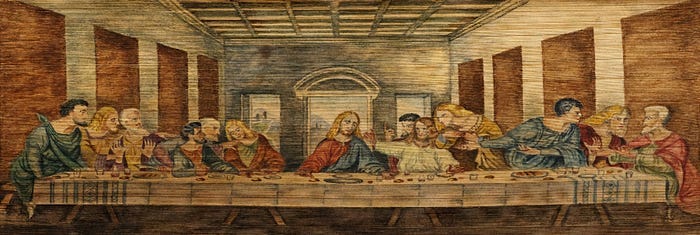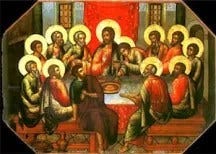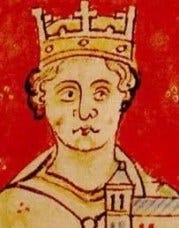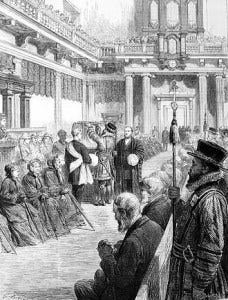
Amid the bustle of Palm Sunday, Good Friday, and Easter, Maundy Thursday is easy to overlook. Few calendars label it, and some churches don’t observe it at all, though it may be the oldest of the Holy Week observances. It’s worth asking why and how generations of Christians have revered this day.
The Middle English “Maundy” comes from the Latin mandatum, meaning “command.” The reference is Jesus’ words to his disciples in John 13:34:
“A new command I give you: Love one another. As I have loved you, so you must love one another.“
Jesus spoke those words at the Last Supper, which took place on the Thursday before Easter.
Alternatives Meanings of Maundy
Later tradition, however, suggests the term comes either from the Saxon word mand, which afterward became maund — a name for a basket, and subsequently for any gift or offering contained in the basket — or from the French word maund, from Old French mendier, which in turn comes from Latin mendicare, meaning “to beg.” It’s the same root from which we get “mendicant order,” or those who rely on the giving of alms.
In both cases, they converge in the English tradition, dating back to England in 1210, when the Crown gave gifts to the poor on this date in a container called a “maund” or “maundy purse.”
Medieval Maundy Thursday Traditions
During medieval times, Maundy Thursday was sometimes called Shere Thursday, where shere means “pure” or “guilt-free.” (“Shere” may also have had something to do with shearing, as it was customary for medieval men to cut their hair and beards on this day and priests to have their tonsures re-cut.) Medieval Christians believed they could achieve purity by performing penance throughout Lent.
The Roman Catholic Church recognized the achievement by formally reconciling penitents and, in some areas, giving them a green branch. During Lent, new converts who had prepared their hearts and memorized their creed were taken through baptism at the Thursday service.
Because of the Maundy Thursday connection with baptism, it has long been a Catholic custom to consecrate the year’s supply of holy oils for baptism, anointing the sick, and Confirmation on this day. Eastern Orthodox clergy take time during the liturgy to prepare the “Amnos,” the Communion elements given to the sick throughout the year.
Roman Catholic Celebration of Maundy Thursday
In the Roman Catholic tradition, Maundy Thursday Evening marks the beginning of the Easter Triduum. A triduum is a space of three days, usually accompanying a church festival or holy days devoted to special prayer and observance.
Maundy Thursday is followed by Good Friday and Holy Saturday and concludes with evening prayers on Easter Sunday.
Protestant Practices of Maundy Thursday
Protestant churches that observe Maundy Thursday may offer a dramatic re-enactment of the Last Supper or another special Communion service. Foot-washing services and adapted Passover Seders are also fairly popular, especially in Anglican, Lutheran, and other liturgical Protestant churches.
Not surprisingly, Protestants generally adhere to Biblical texts when constructing a special service. Catholic and Orthodox traditions add a few other traditions to the observance.
Maundy Thursday in Europe
King John of England
A few European countries have added cultural observances to the list of church traditions. In England, the monarch distributes small purses of Maundy Money to elderly residents of the town selected for each year’s service.
The practice dates back to April 15, 1210, when King John of England — younger brother of Richard the Lionheart — gave garments, knives, food, and other gifts to poor men on Maundy Thursday, following Christ’s mandate to love others.
England
Royal Maundy has continued off and on throughout the centuries and has been held regularly since 1931, with the royal family attending, as a service of the Church of England. Queen Elizabeth II attended all but five during her reign. King Charles III and his wife, Camilla are expected to participate at Durham Cathedral this year.
The King expresses his gratitude to those serving and volunteering in their communities. The service is rooted in the tradition of Jesus washing his disciples’ feet in the Upper Room on Maundy Thursday, the night before his death, and goes back to medieval times.
Germany
Germans, who call the day Gründonnerstag or “Green Thursday,” eat green vegetables, especially spinach.
The association with green may come from the gift of green branches to penitents or from a confusion of the old German words meaning “green” (grun) and “to weep” (greinen), connected to the English word “to groan.”
Bill Petro, your friendly neighborhood historian
billpetro.com
Podcast version:
Subscribe to have future articles delivered to your email. If you enjoyed this article, please consider leaving a comment.







